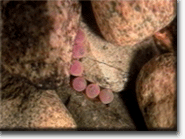 |
 |
Department Of Health Sees No Evil In Radioactive Salmon Spawning Grounds
|
|
|
Contrary to recent official assurances, Washington State’s Department of Health (WDOH) has found europium-152 and other radioactive waste contaminating the Hanford Reach National Monument. WDOH identified radioactivity from the old Hanford nuclear facility in a sample of beach sand from Hanford’s D-Island during a radiological survey in 1995. According to Norm Buske, a scientist studying Hanford’s impact on the Columbia Riverbed, radioactivity in sediments leads to radioactivity in riverbed water, where salmon hatchlings live. That contamination might have profound consequences for wild salmon spawning in the Hanford Reach. Earlier this year, WDOH harshly criticized an August 2002 report by Buske that identified Hanford radioactivity, including europium-152, in Hanford Reach salmon spawning grounds. WDOH assured the public, “It is unlikely than any Eu-152 remains in the Hanford Reach from that time [when Hanford reactors operated during the Cold War]." (See Ref. 1 below.) Buske replies: “WDOH’s criticism of my results, while their own data confirmed my findings, looks suspiciously like Washington State is selling the salmon out to the Department of Energy,” operator of Hanford Site and funder of WDOH’s Division of Radiation Protection. Along with europium-152, WDOH found cobalt-60, cesium-137, strontium-90, and plutonium 239 in its analysis of beach sand from D-island. These findings agree with Buske’s results, published in August 2002 by the Government Accountability Project. The specific data comparison follows:
WDOH radiological results of a total sand sample from downstream D-Island, September 1995 (units: picocuries per gram):
TRAC radiological results of a sieved-and-flotated sand sample #172914, from downstream D-Island, July 2001 (units: picocuries per gram):
Radionuclide produced by Half-life in Years
-----------------------------------------
Ref. 1. “Comments On Hanford radioactivity In Salmon Spawning Grounds,” ERS 02-506, Division of Radiation Protection, Olympia, WA 98504, May 24, 2002. Also at Appendix 3 in
Ref. 2 “Environmental Radiation Program 100-D Island Radiological Survey,” Excerpt of Publication WDOH/ERS-96-1101. See
Contact: Moon Callison, 360.275.1351, mooncal@tscnet.com
|